
The Outer Worlds Review
It’s been a bit of a rough generation for fans of story-based first-person action RPGs. The biggest game of note in recent years has been Fallout 4, which divided fans with its larger focus on action rather than role-playing. Fans of the genre have been looking for something new, something that really lets them delve deep into a character and explore a world however they want.
I’m happy to say that with The Outer Worlds, they need look no further.
You start the adventure in the Halcyon system as a newly-awakened member of a long-hibernating colony ship, The Hope. You are rescued by Phineas Welles, a scientist on the run from The Board, and you decide whether or not you want to help revive the rest of your colony or go with The Board and forge a new path for yourself. That’s oversimplifying it, as there are a lot of ways you can go about getting to the end.
The main quest gives you enough reason to keep playing and has some fun twists and turns to keep it interesting. Although there are only two main endings, there are so many ways to get there and make it your own story, sometimes subtle enough that you may not even notice right away.
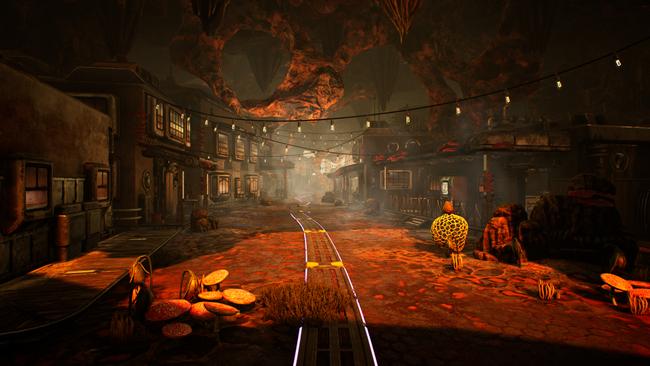
The Outer Worlds is home to some really fun underlying themes. If it wasn’t made clear from the trailers, you’ll be dealing with a lot of corporations and brands across your adventure. Everyone is either trying to sell you something or send you on a quest, and the tongue-in-cheek nature of it all is very entertaining.
Halcyon itself feels incredibly well put-together. Throughout the game, you’ll travel across four or five main locations, and they all feel unique, from the small-town feeling of Edgewater to the fancy reaches of Byzantium, these locations feel very well established. Thankfully they aren’t made any bigger than they needed to be either, so don’t expect to spend hours going from one waypoint to the other, especially with a forgiving fast-travel system.
Considering this is the first game in a potential series, the amount of lore and effort that has been put into creating this world and making it feel lived-in is astounding. The world has a history here, and it doesn’t feel like these characters just exist for you and that’s a big achievement in a game that has you essentially controlling their fate. There is some incredible potential for the future here.
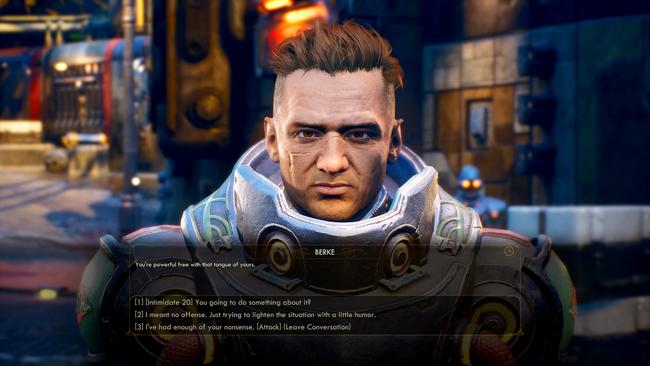
Much has been made in the past of Obsidian’s knack for story-telling and character writing and it returns to The Outer Worlds in spades. Almost every single character you run into in the game is entertaining, and all of them have something interesting to say. Acting across the board is top-quality, and the choices you have in interacting with them seems endless. Obsidian have really shown their razor-sharp wit here.
Humour is also especially well done. There are some genuine laugh-out-loud moments when interacting with people, whether it be how your character can shut everyone else down, or how the NPC’s react to the flamethrower-wielding spaceman wearing a Spacer’s Choice moon on their head. It’s easy to go for cruel and meme-related humour, but Obsidian avoided all of that and made the game more memorable for it.
Speaking of memorable, The Outer Worlds has some pretty fantastic companions as well. Although there are only 6 of them, they feel very fleshed out and participate in the world more than you might expect them to. They’ll react to the world around them, interject during conversations and they can even straight up leave you if you make decisions they don’t agree with. Each companion also has their own quest for you to complete, and these tend to be some of the more involved side quests in the game. Thankfully, the strong characterisation of each of the companions means that completing these quests seems just as important as the main storyline.
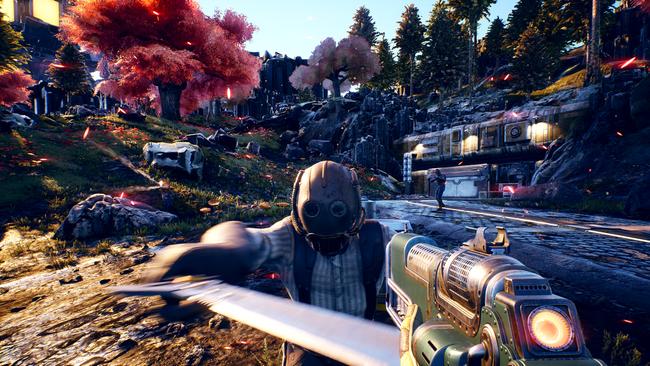
By far one of the biggest strengths of The Outer Worlds is its role-playing. The claim that you can ‘play however you want to’ is gloriously true. Want to kill every NPC? You can do just that, you little sociopath you. Want to go it alone and stave off every possible companion? That’s an option as well. Dialogue options are varied and don’t result in the same outcome every time, and there’s a range of choices for every situation. Conversations are easily some of the most fun in the game.
The depth of role-playing can also be seen in actually creating and shaping your character as well. You go through the same process of putting points into your character every-time you level up, but there’s a range of sub-categories that make it much more interesting. For example, the dialogue skill tree has three different sections- Lie, Persuade and Intimidate, which can eventually be levelled up individually.
The Outer Worlds also introduces the ‘flaws’ system alongside a range of really-well implemented perks. Depending on how you’re playing, the game will occasionally give you the option of taking a flaw in that actively hinders your character such as taking more damage from plasma. In exchange, you’ll get a perk point, which is actually a good exchange as all of the perks are actually pretty helpful. The system is entirely optional, but it makes role-playing feel a lot more involved.
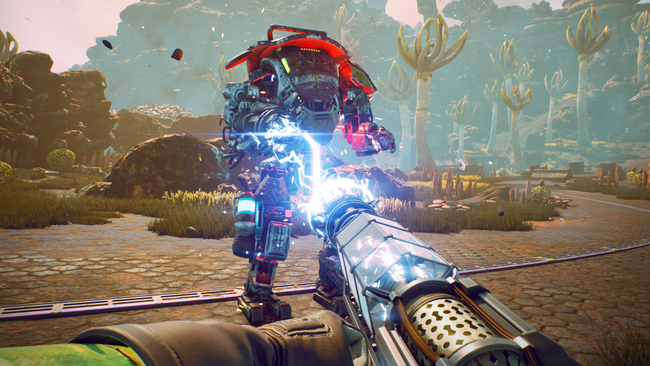
For my main playthrough I decided to help Phineas and try and be as morally right as possible. I’d steal only if I needed to and I generally looked out for the best in everyone. This was a far cry from my second time through, where I took a ‘shoot-first, ask questions later’ approach, which definitely made the game a little easier. The range of options here made more than one playthrough feel worth it.
Really it felt like the only thing missing are romance choices, but it feels like Obsidian chose between forcing those in just to check off a box, or leaving them out to focus their efforts on other things, which to me definitely feels like the right call.
Although role-playing is a significant focus in The Outer Worlds, that’s not to say that combat doesn’t play a big role too. Firefights are frequent whether you play carefully or not. That’s not a bad thing though, as combat is actually a lot of fun, although it's not the highlight of the game's strengths. Unfortunately the guns are all pretty standard fare, although there are a few more interesting choices like a shrink ray.
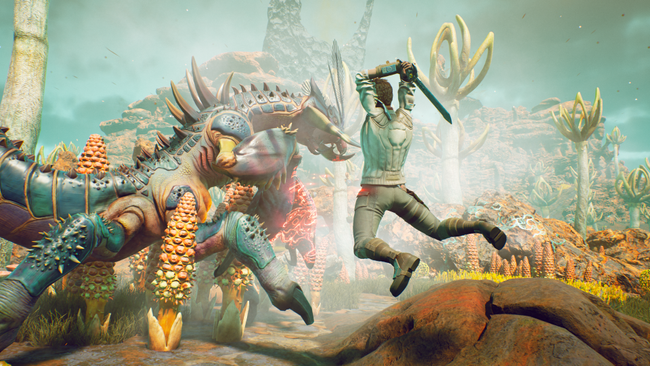
Shooting is fairly typical aside from the introduction of Tactical Time Dilation. Tactical Time Dilation acts as a semi-replacement for V.A.T.S., allowing the player to slow down time whilst fighting. Shooting the enemy in specific places will cause status effects like blinding or staggering, which makes it an incredibly useful tool. Combining this with the ability to dodge when double-tapping jump, and combat becomes a very involved affair. It’s actually a lot of fun, even if it starts to drag towards the endgame.
Although there are some really good side-quests, unfortunately there are also a lot of the typical fetch quests and bounties. Considering the game world itself isn’t too big, a lot of these quests feel like unnecessary padding for an RPG that’s actually just the right size. Saying that, there are some side-quests that’ll actively have you pausing what you’re doing just to finish them, and these can be some of the surprising highlights of the game.
The Outer Worlds isn’t a particularly beefy RPG either. Playthroughs can take anywhere between 15-30 hours depending on how far you go with side-quests. This isn’t necessarily a bad thing though, as the game itself feels like a complete package. There’s nothing here that screams missing content.

Despite all the good there is in The Outer Worlds (and that’s a lot), there is an elephant in the room- the presentation. There’s just no escaping it, The Outer Worlds is not a well-presented game. Character models are all underwhelming, textures are unpolished and the sound design is okay at best and flat at worst.
This is a big shame because artistically The Outer Worlds actually has some great ideas, it’s just let down by lacklustre visuals. It’s like a Range Rover being powered by a Reliant Robin. Just take a look at the loading screen artworks for an idea of what The Outer Worlds wants to achieve. Saying that, in my playthrough I actually didn’t run into any substantial bugs. There were some occasional UI glitches, but nothing that made quitting out of the game essential and nothing that detracted too much from the overall experience. Considering how buggy some of Obsidian’s previous releases have been, this was a nice surprise.
There are some other smaller areas that The Outer Worlds doesn’t quite deliver on as well. The lack of a third person camera is disappointing and makes customisation almost entirely pointless. The range of armours and weapons are also pretty bare, which is a little confusing considering the game’s focus on branding, although that is somewhat made up for by the obscene amount of consumables that can be collected.
The presentation being lacklustre should in no way be a dealbreaker though. Obsidian have crafted a smart, witty, deep RPG experience that feels confident in its own shoes. It keeps its focus on having good role-playing mechanics, whilst still managing to have an involved combat system that improves on what we’ve seen done in the genre before. Microsoft and Obsidian seem set on making The Outer Worlds a franchise, and if that’s the case then this is a hell of an introduction.